Nevada is one of the most rugged states in the United States. While the glitzy lights of Las Vegas may be what comes to mind first, there’s more to Nevada than casinos and concerts!
The Silver State is bordered on the west by the Sierra Nevada mountain range with Lake Tahoe high up in the mountains. There are also deep canyons and rough terrain that allow wildlife to thrive. You’ll find about 28 snake species in Nevada, from the gentle northern rubber boa to the insanely toxic Mojave rattlesnake.
Snakes thrive in many habitats, but Nevada’s climate leans heavily toward desert scrub once you leave the Sierra Nevadas. The snakes out there are tough and adapted to a harsh, unforgiving climate.
Here are the snakes you’re most likely to see in Nevada, whether you’re out in the desert or taking a detour from hiking the Pacific Crest Trail.
13 Snakes to See in Nevada
While 28 species may seem like a lot of different snakes, it’s important to remember that most of them are harmless, and some are so small you’ll never see one.
1. Great Basin Gopher Snake (Pituophis catenifer deserticola)
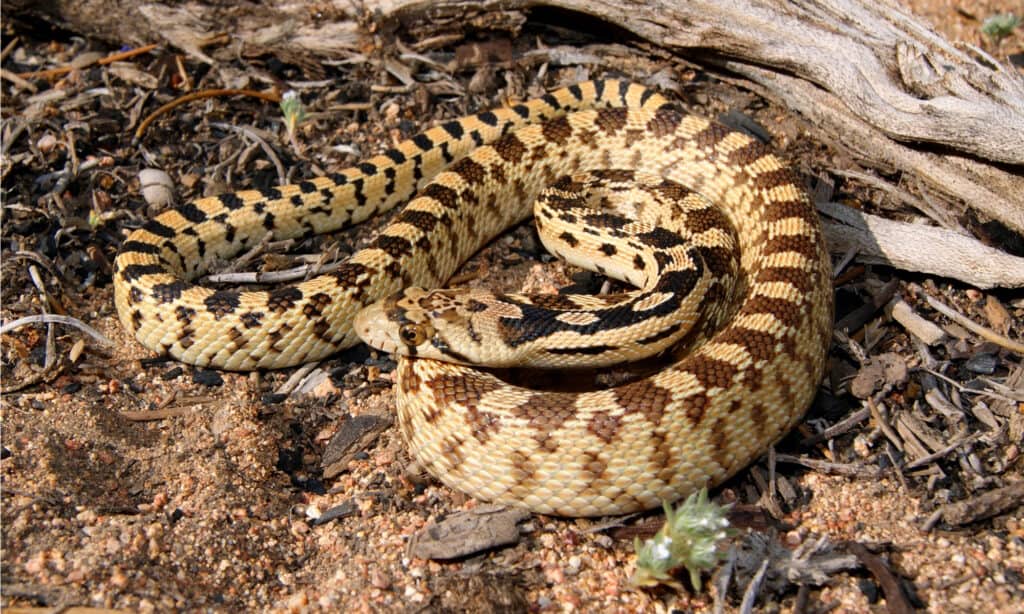
Great Basin Gopher Snake, Pituophis catenifer deserticola
©Matt Jeppson/Shutterstock.com
Of all the snakes you’ll likely see in Nevada, the Great Basin gopher snake is mostly likely the one. It’s one of several gopher snake subspecies across North America and occurs across Nevada.
All gopher snakes are terrific bluffers. They do the best impression of a rattlesnake by coiling up into an S shape, rattling their tail against the ground, and hissing loudly. Then they strike at you with their mouth closed. So, it’s more like a head-butt.
Like the other subspecies, Great Basin gopher snakes are big and muscular. They aren’t as long as other subspecies and average around four and a half feet long. The longest one on record was almost six feet long (5.75). Great Basin gopher snakes have dark brown or black spots on their backs that connect by narrow lines running along each side. Their base color is lighter brown, and they have keeled scales. These harmless snakes are fantastic rodent control and help keep those populations in check.
2. Striped Whip Snake (Masticophis taeniatus)
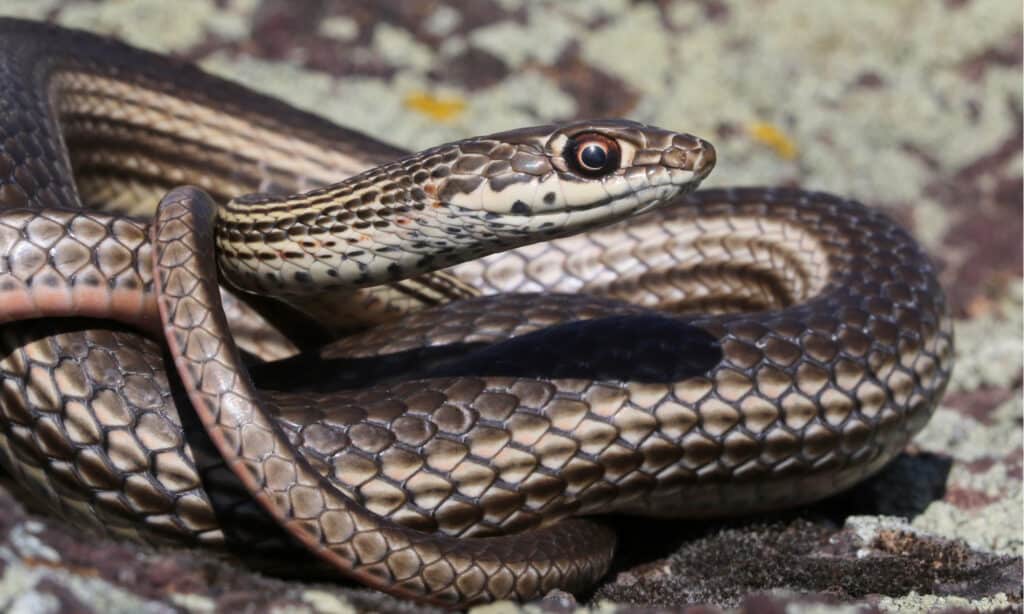
Striped whipsnakes are fast-moving and used to be in the same genus (
Coluber) as racers.
©Randy Bjorklund/Shutterstock.com
These harmless nonvenomous snakes range across all of Nevada. They can reach six feet long but typically stay a bit smaller.
Striped whipsnakes have long thin bodies, with scale markings that look like a braided whip — which is where they get their name. They’re usually black, brown, or gray and have white or cream-colored stripes on each side of their back, which are usually solid and dark-colored.
These snakes are active daytime predators. Striped whipsnakes take shelter during the hottest part of the day, but otherwise, they’re out hunting everything from mice and rats to rattlesnakes. Yes, these harmless, fast-moving snakes eat the dangerous snakes whose rattle sends a chill down your spine.
The striped whip snake’s preferred place to live is in sagebrush, canyons, and in flat desert lands like Nevada. It can also be found in the mountains and sometimes near streams.
3. Western Yellow-Bellied Racer (Coluber constrictor Mormon)
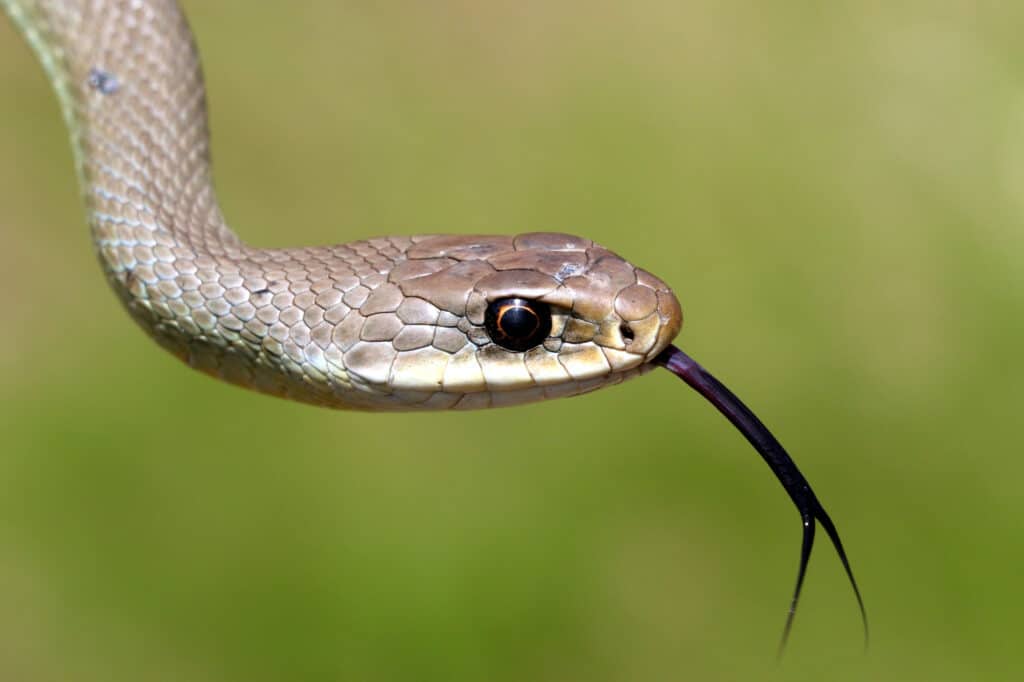
A Western Yellow-bellied Racer (Coluber constrictor mormon) with tongue out
©iStock.com/randimal
Western yellow-bellied racers are closely related to whipsnakes, and the two groups used to be classified together in the Coluber genus. These snakes are common in the northern half of Nevada, where they cruise the landscape, looking for food. Racers have a varied diet which includes rats, mice, small rabbits, frogs, toads, turtles, lizards, and even other snakes. Some of them climb trees to eat bird eggs.
As young snakes, western yellow-bellied racers have blotches on their backs and sometimes get confused for other species like kingsnakes. However, as they mature, they lose that pattern and become solid colors like black, green, brown, black, or blue on the top with yellow, white, or light tan belly. They can grow up to five feet long, but the record was a little over six feet (73 inches).
4. Ground Snake (Sonora semiannulata)

On average, Western Ground snakes are 8 inches long.
©Matt Jeppson/Shutterstock.com
This cute little snake is harmless and present in the western and southern portions of Nevada. Ground snakes have variable patterns and can be banded with black or brown and orange or red, striped, or solid-colored — all in the same region. It only grows to about 19 inches as an adult and has smooth scales.
The most common place you’ll find them is at night along the side of the roads or in drainage ditches, where they forage for spiders, scorpions, centipedes, and other invertebrates.
5. Northern Rubber Boa (Charina bottae)
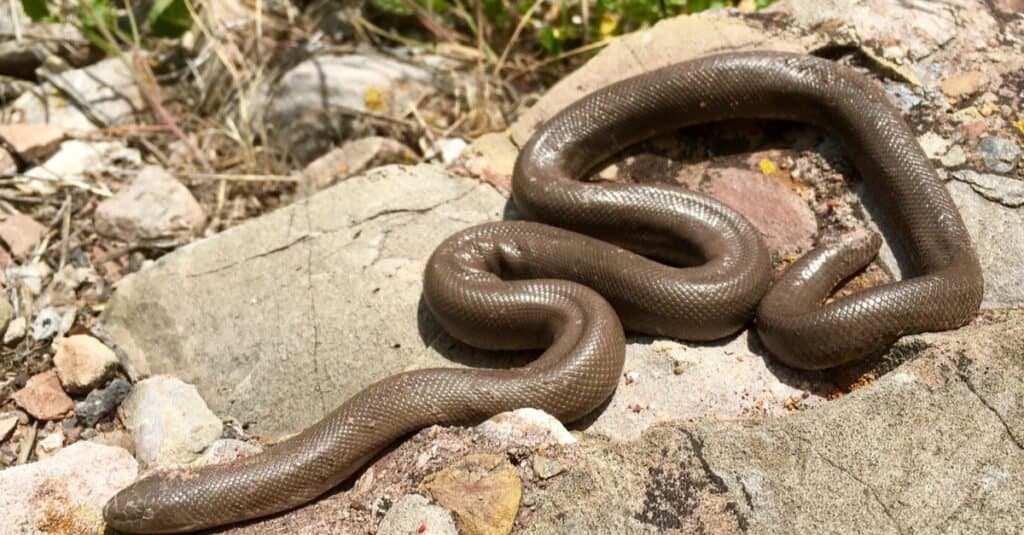
Rubber Boas are docile snakes that almost never bite.
©Matt Jeppson/Shutterstock.com
The Northern Rubber Boa snake is only found in northern Nevada, so unless you travel that way and visit the Tahoe area, you may never see one. They can be hard to spot because they are small nocturnal, spending most of their time underground.
These snakes are usually only about two feet long and have loose, baggy skin with tiny scales that give them an oily appearance, much like rubber. Their color varies between tan, dark brown, yellow, orange, and olive-green, with a lighter belly color.
Rubber boas are one of the most docile snakes you’ll ever see, and educational programs often use them as ambassador animals to help people deal with a fear of snakes. Unfortunately, it’s their docile nature that makes them a target for pet-trade collection. However, they’re easily available from breeders, so there’s no need to abduct one from the wild.
This species eats a variety of young mammals, like shrews, voles, and mice. They’ll even try to eat the entire litter of nestlings when they find them by fending off the mother with their tail.
6. Red Coachwhip (Masticophis flagellum piceus)
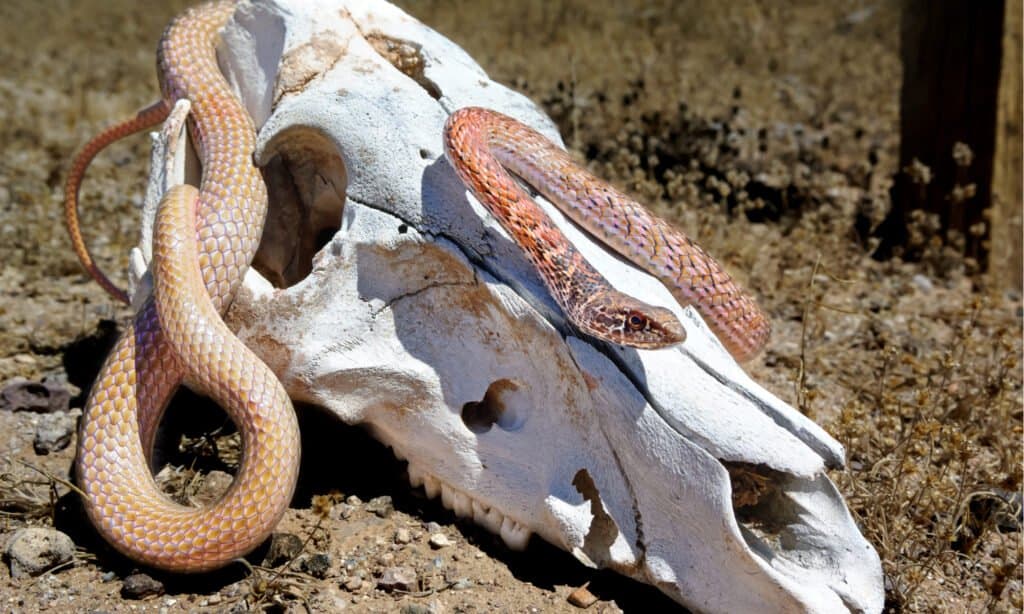
Coachwhip snakes are non-aggressive snakes and non-venomous.
©Deep Desert Photography/Shutterstock.com
These snakes are just as fast-moving as racers and actively hunt during the day. Red coachwhips (and coachwhips in general) scare the snot out of people because of their behavior. They have excellent eyesight and use it to track down prey, often cruising through the grass and scrub-brush with their heads up to get a better view.
Red coachwhips are common in southwestern Nevada, where they eat a varied diet that includes eggs, birds, amphibians, rats, mice, or snakes. These snakes are long and slender with large eyes and can grow to seven feet long, although most are smaller. Also called red racers, these snakes can be red, rusty red, olive-brown, or orange-tan.
7. Western Patchnose Snake (Salvadora hexalepis)

Western patchnose snakes burrow using a raised scale on their snout.
©Joe McDonald/Shutterstock.com
The western patchnose isn’t named because of a colorful patch, but because of a raised scale on its snout. Its raised scale is useful for burrowing in loose sandy soil and gravel for its prey, which is primarily grasshoppers, small mammals, lizards, and reptile eggs.
Native to the southwestern United States and Baja California, Mexico, the western patchnose is most common in southwestern Nevada. They’re yellowish brown with black or dark brown lateral stripes, and these snakes measure between two and four feet long and are completely harmless.
Venomous Snakes In Nevada
There are only a handful of venomous snakes in Nevada. And, because they’re all rattlesnakes, you’ve got a chance at a warning before they strike. However, no matter how relaxed the rattlesnake is, if startled, a rattlesnake will strike without warning.
Since most bites happen on the hands, feet, and sometimes face, one of the easiest ways to avoid being bitten is to keep your hands and feet where you can see them. You’ll be much safer if you avoid stepping or reaching into a place where you can’t see the ground.
Give snakes the room they need to make a clean getaway and you can enjoy their beauty without a hospital trip. Remember, all rattlesnake bites are medical emergencies. While up to 25% of bites are dry — with no venom injected — that’s not something you want to trust.
8. Panamint Rattlesnake (Crotalus stephensi)
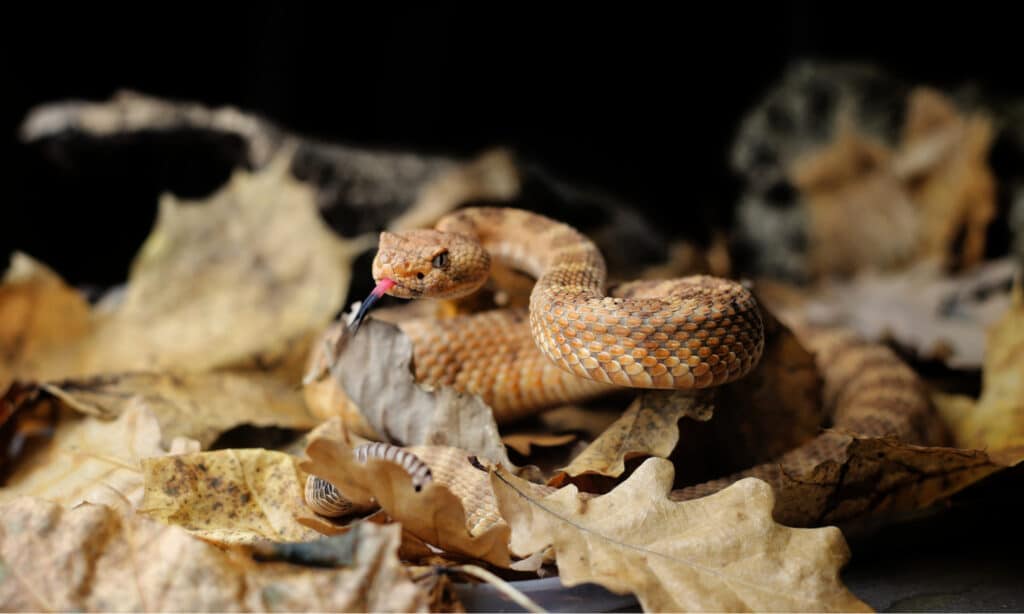
Panamint rattlesnakes are smaller, but don’t let that fool you — their bite is dangerous too.
©Marina Kehl/Shutterstock.com
This small rattlesnake has a small range in southeastern California and southern Nevada. Panamint rattlesnakes can grow to four and a half feet but average between two and three feet long. Their base color varies and can be shades of tan, straw, gray, or brown with darker splotches down the length of their backs. Like other rattlesnakes, it takes small mammals, birds, and lizards by ambush.
Just like their larger cousins, these rattlesnakes blend in like a soldier in a ghillie suit. Keep to the trails so you can see where you’re going — preventing bites is easier than you think!
9. Sidewinder (Crotalus cerastes)
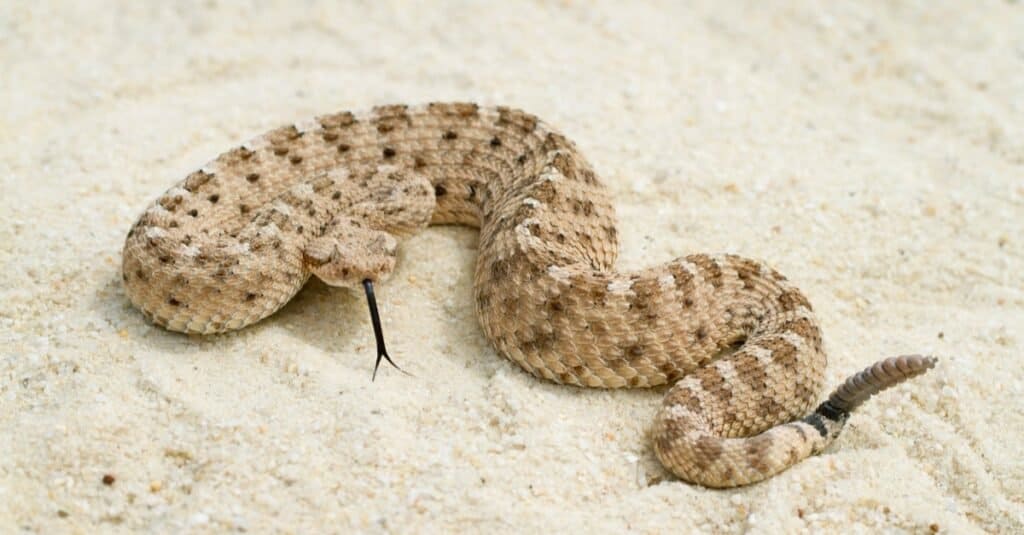
Venomous Sidewinder Rattlesnake (Crotalus cerastes) with forked tongue scenting the air, lying on the desert sand.
©Mark_Kostich/Shutterstock.com
Sidewinders can look intimidating even though they’re smaller rattlesnakes; most adults are only about two and a half long. They’re called sidewinders because they move in a peculiar sideways motion instead of directly forward. This sidewinding motion allows them to move quickly across the hot desert sands where they make their home, only touching one or two coils on the ground at a time.
Typically light tan or brown with darker brown or cream markings, sidewinders blend into their habitat seamlessly. However, just because they blend nicely into the arid desert surroundings of southern Nevada, there is no mistaking the rattle. Just like other rattlesnakes, sidewinders have a great rattle to warn you away.
These snakes eat lizards when they’re young, often using their tail to attract the attention of their prey. Sidewinders stop using the caudal (tail) lure when they transition into adult prey like desert-dwelling rodents, birds, and other snakes.
10. Mojave Rattlesnake (Crotalus scutulatus)

Near the California border and around Henderson, Nevada you’ll find Mojave rattlesnakes.
©Shoemcfly/iStock via Getty Images
Nevada’s southern tip seems to have a great selection of rattlesnakes for you to see! Near the California border and around Henderson, Nevada you’ll find Mojave Rattlesnakes. They’re various shades of brown, often with a green hue that leads to their other name: Mojave green. They have darker roughly oval-shaped saddle markings outlined in black, wide dark stripes outlined with white or cream behind their eyes, and irregular bands at their tails.
This species has particularly potent venom, containing a neurotoxin called Mojave toxin, making their bite especially dangerous. However, not all Mojave rattlesnakes have the neurotoxin and scientists are trying to figure out if there’s a pattern to which populations have it and which don’t.
Although Mojave rattlesnakes have a nasty reputation, it’s not because they’re out to get you. They’re almost as testy and nervous as western diamondbacks, but aggressive isn’t a thing for rattlesnakes.
11. Southwestern Speckled Rattlesnake (Crotalus pyrrhus)
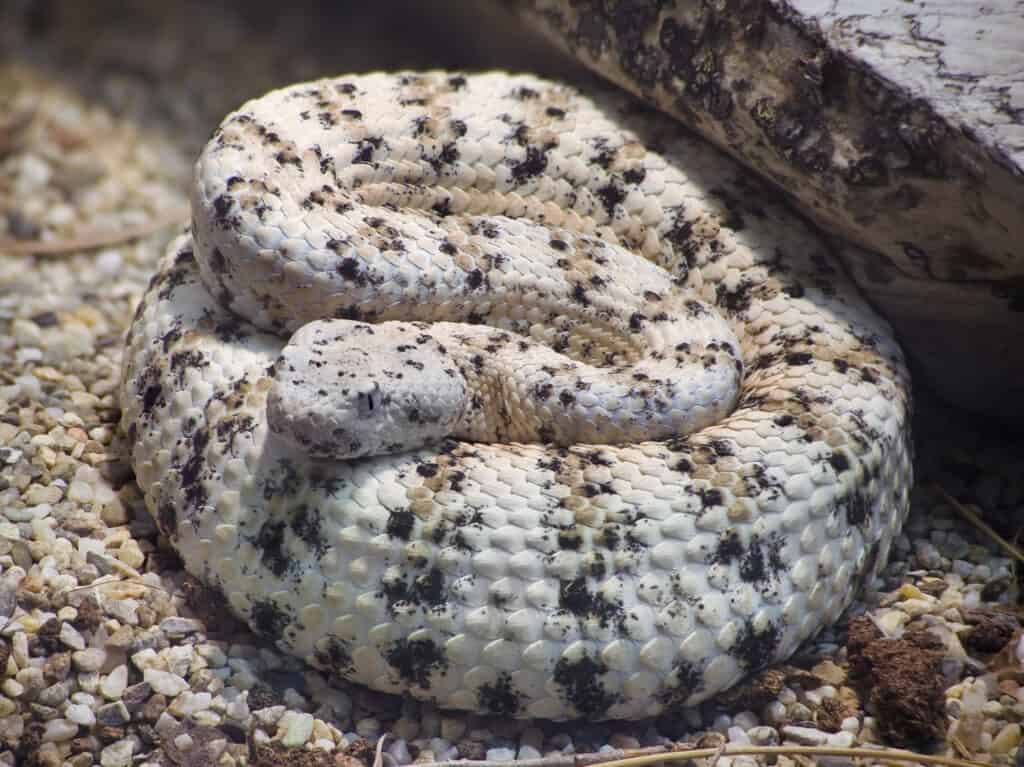
The Speckled Rattlesnake colors help it to blend into the rocks, but when it’s out hunting, you should be able to see the white body color clearly.
©Dario Sabljak/Shutterstock.com
The southwestern speckled rattlesnake isn’t widespread in Nevada — they’re only in the southeastern corner where the rocky ledges and hills make terrific shelter.
Southwestern speckled rattlesnakes vary widely in color and pattern, depending on where they live. Their base color can be white, pink, tan, or gray and speckled with white and black. If there are markings, they’re not usually clearly defined and have speckling in them. These snakes usually grow to about three feet long but four-footers aren’t unusual.
These snakes are opportunists and one was even found hanging out around a bird bath, eating the birds as they came to visit. Typically, they take rats, mice, other small mammals, lizards, and birds.
12. Western Diamondback Rattlesnake (Crotalus atrox)

Western diamondback rattlesnake displaying its characteristic defensive posture.
©Alexander Wong/Shutterstock.com
Western Diamondback Rattlesnakes are rare in Nevada. They only inhabit the far southern corner of the state, near Lake Mojave. These snakes have very pale gray or tan bodies with diamond-shaped markings in dark brown, dark gray, and white that run all the way down their bodies until their tail which has black and white bands. Like most rattlesnakes, they aren’t usually very long and average about four feet long. However, the longest they can grow is probably closer to seven feet!
Fortunately, while these snakes have a bad reputation, it’s not because they’re aggressive. No, it’s exactly the opposite. They operate on the idea that everything, including that butterfly, is out to get them. These snakes are extremely nervous and rattle and the first sign of danger. So, if you give it time, the western diamondback is more than happy to get out of your way.
13. Great Basin Rattlesnake (Crotalus lutosis)
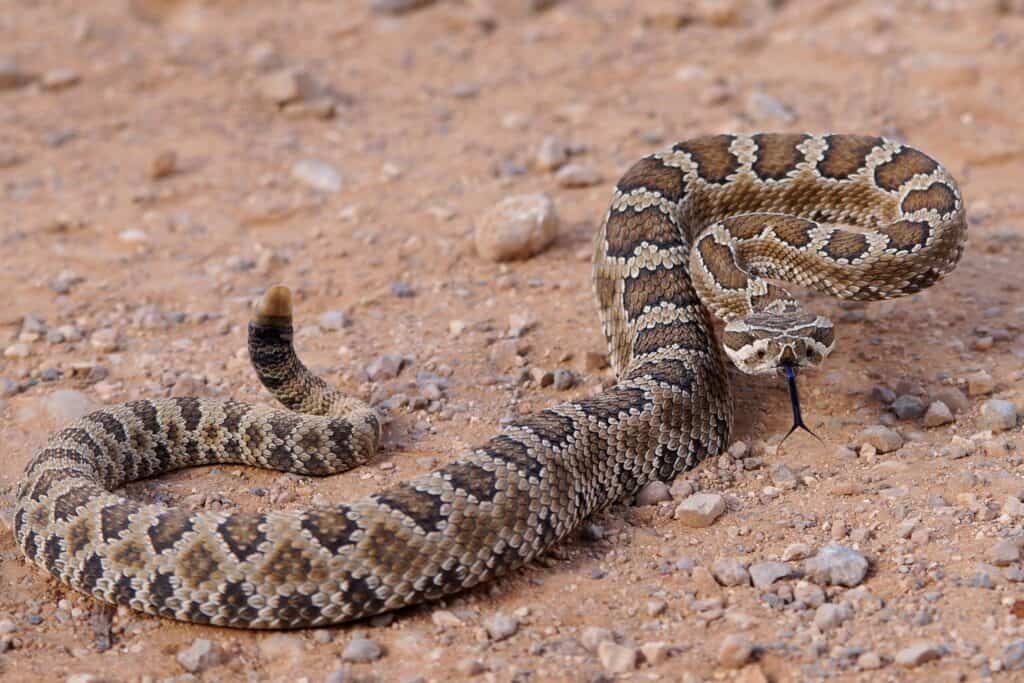
Great Basin Rattlesnakes are only between two and four feet long, so they aren’t that large, but they blend into the surroundings extremely well.
©Matt Jeppson/Shutterstock.com
The Great Basin Rattlesnake is another venomous snake native to Nevada. It inhabits dry rocky outcrops and scrub brush in the northern three-quarters of the state, where it eats rodents of all types. This rattlesnake has beautiful oval-shaped markings outlined in black and white over a lighter base color. It doesn’t have black and white bands on its tail; they’re more brown and tan.
This snake averages just three feet in length and, like other rattlesnakes, has a mighty venomous bite. Great Basin Rattlesnakes are sand colored or light brown or tan, with dark brown markings. They are usually seen basking near hiking trails and other pathways, so vigilance is your best defense.
Staying Safe Around Nevada’s Snakes
Although there are another 15 or so snakes in the state, don’t worry. They want to stay away from you too! So, don’t let a fear of snakes keep you from exploring Nevada. The natural landscape in Nevada is a little intimidating in places but snake safety is straightforward.
- Always place your hands and feet where you can see them.
- Don’t pick up snakes if you can’t identify them — and even if you can, rattlesnakes are nothing to play with.
- If you can leave it alone to do its job, that’s great! Snakes are vital to the ecosystem.
| Species | Where in Nevada | Venomous? |
|---|---|---|
| Great Basin Gopher Snake | Common statewide | No — but it will fake you out |
| Striped whipsnake | Common statewide | No, it’s harmless |
| Yellow-bellied racer | Common statewide | No, it’s also harmless |
| Ground snake | Southwestern Nevada | It’s harmless |
| Northern rubber boa | Northern Nevada | No, it’s a harmless boa |
| Coachwhip | Southwestern Nevada | Harmless colubrid |
| Western patchnose snake | Southwestern Nevada | Nonvenomous, harmless! |
| Panamint rattlesnake | Southern Nevada | Venomous!! |
| Sidewinder | Southern Nevada | Venomous!! |
| Mojave rattlesnake | Southern Nevada | Venomous and cranky!! |
| Southwestern speckled rattlesnake | Southeastern Nevada | Venomous!! |
| Western diamondback rattlesnake | Southern Nevada | Venommous and cranky!! |
| Great Basin rattlesnake | Northern 2/3 of Nevada | Venomous!! |
The photo featured at the top of this post is © Michael Benard/Shutterstock.com
Discover the "Monster" Snake 5X Bigger than an Anaconda
Every day A-Z Animals sends out some of the most incredible facts in the world from our free newsletter. Want to discover the 10 most beautiful snakes in the world, a "snake island" where you're never more than 3 feet from danger, or a "monster" snake 5X larger than an anaconda? Then sign up right now and you'll start receiving our daily newsletter absolutely free.
Thank you for reading! Have some feedback for us? Contact the AZ Animals editorial team.







